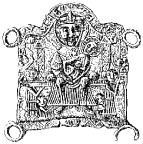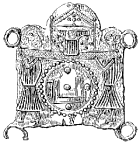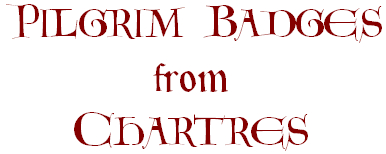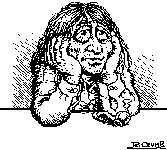(Click
on an image to see a larger version.)

Badge 1, recto
N.b.
The images of Badges 1 and 2 --and those of the slightly larger ones
to which they are linked-- should be considered inherently unreliable
in their details.
They are, after all, digitalized versions of recently
made photocopies, of 19th century printings, of woodcuts(?) made for
publication, after, presumably, the fragile and soft pewter originals
--which themselves had lain in the mud of the Seine for several centuries
before being recovered in 1863, and which have, apparently since been
lost again (?)
--I'd love to hear that this last is not true or that these
objects have been published anywhere else, after the originals).
When one considers that the 13th century artisan who carved
the (stone?) moulds from which the original metal exemplars were cast
was, himself, rendering as best he could the objects he wished to
portray, it's worth keeping in mind that we are here very, very far
away from a view of, for example, the cult statue of the Virgin.
|
Badge 1,
recto
The first (by apparent date)
of the four known Chartres badges was found near the Pont Neuf in Paris
in 1862, and seems to date from the early 13th century.
It is roughly rectangular in form (having a partial
trilobed arch on the top edge), with four holes at the corners for affixing
it to, presumably, an article of clothing.
On one side of this badge is a seated Virgin, crowned
and nimbed, with the Child (in a cruciform nibmus) largely off center
on her left leg, holding in his left hand the Orb.
She may be holding a staff topped with a fleur-de-lys
in her right hand, though it is curious that this feature —which is
prominently articulated in various later examples— is barely visible
(if at all) here (perhaps due to damage to the original).
Her crown appears to be of a type found from at least
the early 13th century, with four fleur-de-lys cardinally placed and
longitudinally placed jewels in between; and she is seated on, perhaps,
a cushion, the round ends of which are visible on either side of her,
it in turn resting on some sort of bier, the ends of which are carried
on the shoulders of two clerics (?), wearing long vestments, cinched
at the waist, who march from left to right.
Below these two —and much smaller in scale— are two
figures on each side of the Virgin who seem to be touching the sacred
hem of her dress. Two curious "towers," one on each side of
the Virgin, are also on the bier . They are decorated (?) with a lozenge
pattern, jewels (?) to be seen within each of the lozenges, and each
tower topped by triangular (pyramidal?) form, itself capped with a round
(spherical?) object. These vertical elements perhaps suggest the decorated
throne on which the Virgin is often depicted. Above the Virgin (or rather,
Her statue), and in part framing her head in the center, is a trilobed
arch, containing the inscription: S[IGN]VM BEATE MAR[I?] [A??], with
the "B" and the second "E" being in reverse.
|

Badge 1, verso
(Published: Arthur
Forgeais, Collection de Plombs historiés trouvés dans la Seine,
duxième série, Enseignes de Pèlerinages (Paris, 1863), p. 28;
A.
Lococq, "Notice historique sur les enseignes de pelerinages et les
chemissettes de Notre-Dame-de-Chartres," Societé
archéologique d'Eure-et-Loir,
VI, 1876, pp. 194-242; Jane Williams, Bread, Wine and Money
(Chicago, 1993), fig. 139.)
|
Badge
1, verso.
On the reverse of this badge
is a somewhat similar scene: two clerics (? again with long vestments,
cinched at the waist), carrying (right to left) a bier, this time with
an apparent shrine (the "sainte châsse," presumably) on top,
inside[?] of which is, perhaps, the first surviving representation of
the relic known as the camesa of the Virgin, the "shirt" which
She was said to have worn when giving birth to the Christ (here seen
in a 17th century manuscript painting
of the arms of the Chapter).
Both flanking and above the image of the camesa,
under its pitched reliquary[?] roof are a few "jewels." Between the
two "clerics" who carry the reliquary is a large roundel, surrounded
by a ring of round "jewels," within which is, perhaps, the curious emblem
which may represent the town itself (Forgeais calls it a "denier chartrain,"
and it seems to have an early form of the "arms" of the city which is
found on contemporary coinage).
|
| Badge
3, recto |
Badge 3, recto
From the group found in
the Seine in 1862 Forgeais also publishes another badge, its imagry
somewhat similar in form and content on the recto: the Virgin is seated
on a finely turned throne, above an arcaded footstool, with the Child
balanced in the cruck of her left arm.
She holds a staff topped with a prominent fleur-de-lys
in her raised right hand while the Child holds an Orb in his left.
She wears a stole over her head and shoulders, a crown
with multiple fleur-de-lys, a jewelled border on the neckline of her
undergarment, and a very prominent, lozenge-shaped broach with a cruciform
pattern within it at the center of her breast.
The whole is beneath a trefoil arch (perhaps topped
with architectural motifs which have broken away) with the inscription
"SIGNV[M] BEATE : MARIE".
On each side of
the main image, however, the two figures have become kneeling supplicants
and seem to wear different dress.
Unlike the earlier badges, there seems to be an attempt
here to more fully articulate the postures and draperies of the figures
displayed. The Virgin has lost her residual axiality, her head tilts,
ever-so-slightly, towards the Child, the folds of drapery between her
knees are noted, and the two kneeling supplicants (the clerics carrying
the bier have disappeared all together) have become prominent.
On the reverse side, we again see the camisa,
here with a cross-hatched pattern, flanked by two fleur-de-lys, perhaps
within a stylized, bejewelled châsse (the top of the badge has
not survived in tact) , between two columns (part of the châsse?).
The bier and its barers have disappeared, but below
the fully-displayed camisa is again a roundel --a "denier
chartrain," according to Forgeais-- with something resembling the
arms of the city (with fleu-de-lys) within it.
Forgeais suggested that this badge dates from the 14th century.
|




